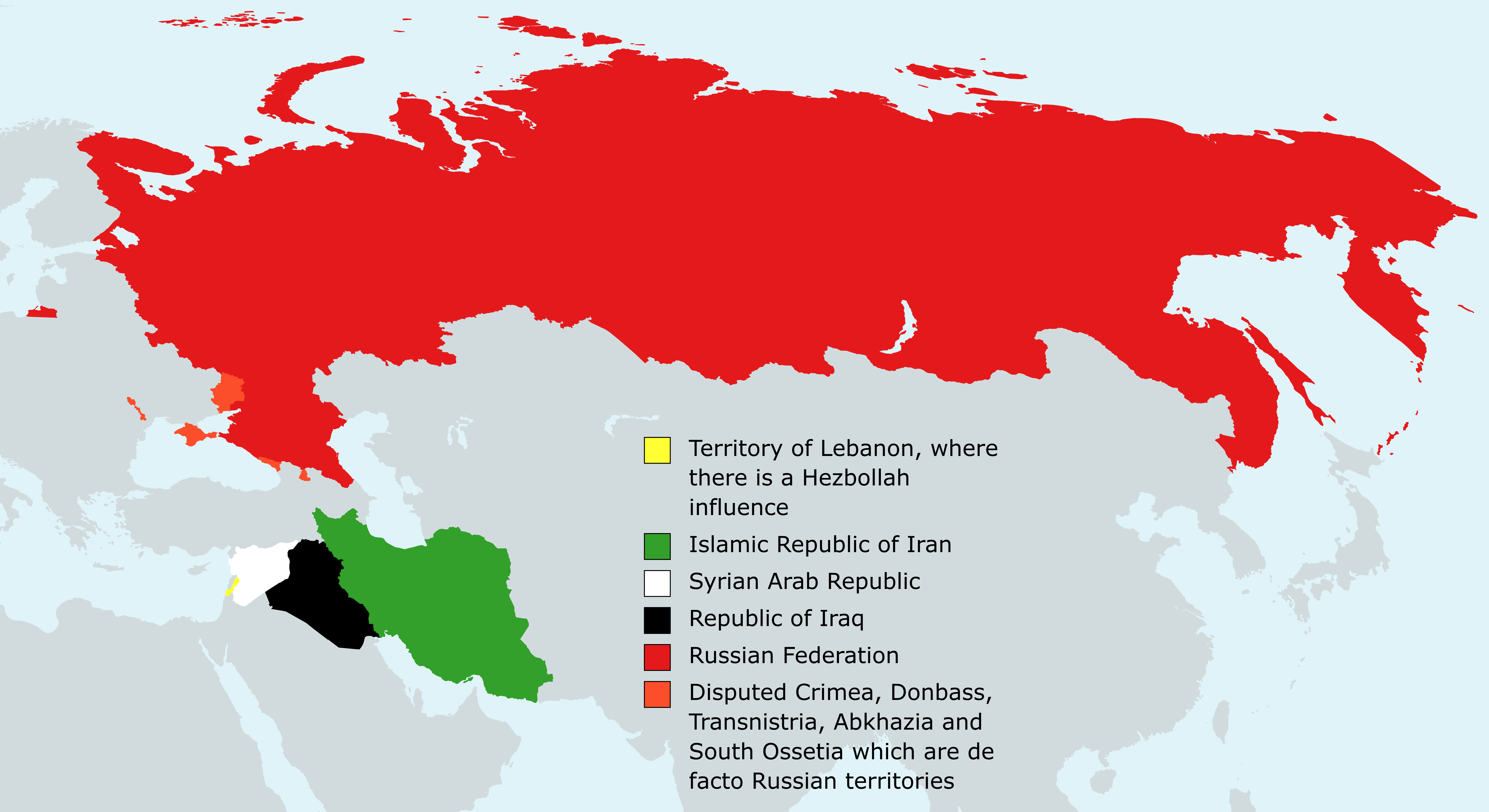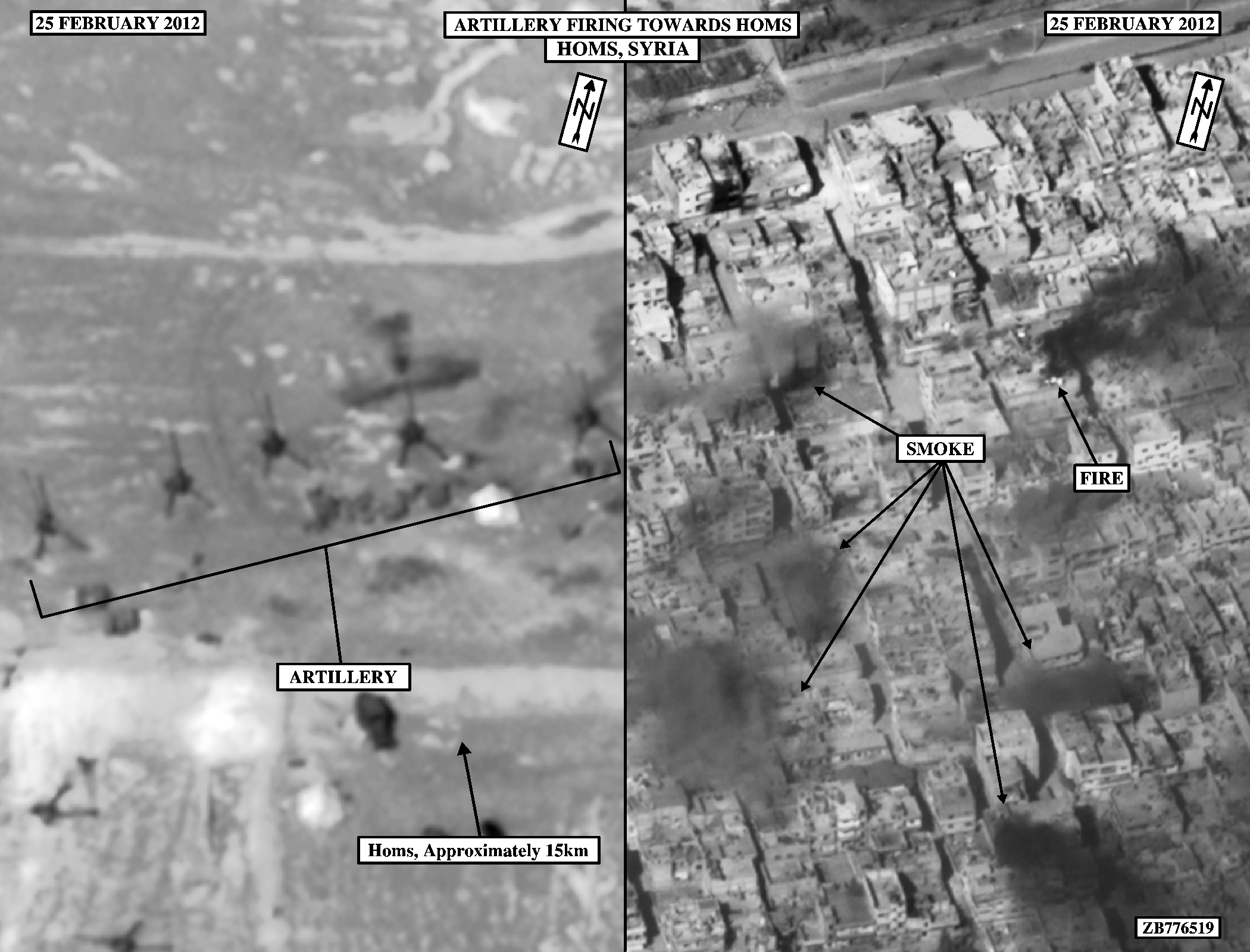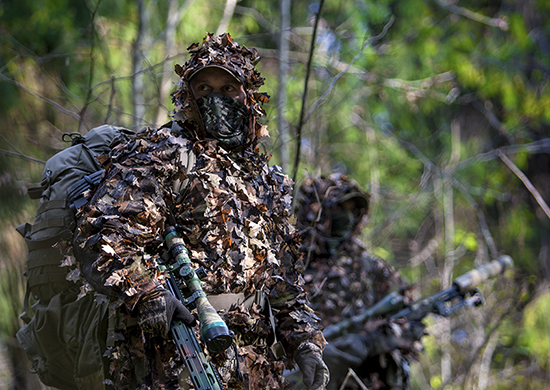|
Homs Offensive (November–December 2015)
The Homs offensive from November to December 2015 was launched by Syrian government forces during the Syrian Civil War in November 2015. The objective of the operation was to recapture territory lost to ISIL, in the eastern part of the Homs Governorate, during the fall of that year. The offensive On 5 November, Syrian government forces launched the offensive from the Mahin- Sadad checkpoint and recaptured the Tal Sinni, Tal Hazim, and Al-Wastani hilltops, after clashes with ISIL. Two days later, they carried out an assault at the eastern slopes of the Jabal Al-Hiyal Mountains, seizing several points and advanced to east towards the ancient city of Palmyra. On 14 November, Syrian government forces captured the hilltop of Tal Hazim Al-Thalatha. Additionally, two days later, they seized the Tal Syriatel, Jabal Ma'ar, Al-Bayarat, the Ancient Palmyra Quarries, Al-Kassarat and Al-Dawa area outside the city of Palmyra after a series of intense firefights with ISIL. On 17 November, Sy ... [...More Info...] [...Related Items...] OR: [Wikipedia] [Google] [Baidu] |
18th Armoured Division (Syria)
The 18th Armoured Division ( ar, الفرقة المدرعة الثامنة عشر or الفرقة المدرعة 18) is one of two autonomous reserve divisions of the Syrian Arab Army, the other being the 17th Division. Structure This is the smallest conventional division in the Syrian Arab Army with only about 7,000 men. Its force structure is made up of the: *131st, 134th and 167th Armored Brigades *120th Mechanized Brigade *64th Artillery Regiment Syrian Civil War The division was in a reserve role leading up to the summer of 2013. Since then it has been heavily engaged in the Syrian Civil War. The European Council named Major General Wajih Mahmud as commander of the 18th Armored Division in the ''Official Journal of the European Union'' on 15 November 2011, sanctioning him for violence committed in Homs. Henry Boyd of the IISS noted that "... in Homs, the 18th Armored Division was reinforced by Special Forces units and ... by elements of the 4th Division under ... [...More Info...] [...Related Items...] OR: [Wikipedia] [Google] [Baidu] |
Military Operations Of The Syrian Civil War In 2015
A military, also known collectively as armed forces, is a heavily armed, highly organized force primarily intended for warfare. It is typically authorized and maintained by a sovereign state, with its members identifiable by their distinct military uniform. It may consist of one or more military branches such as an army, navy, air force, space force, marines, or coast guard. The main task of the military is usually defined as defence of the state and its interests against external armed threats. In broad usage, the terms ''armed forces'' and ''military'' are often treated as synonymous, although in technical usage a distinction is sometimes made in which a country's armed forces may include both its military and other paramilitary forces. There are various forms of irregular military forces, not belonging to a recognized state; though they share many attributes with regular military forces, they are less often referred to as simply ''military''. A nation's military may f ... [...More Info...] [...Related Items...] OR: [Wikipedia] [Google] [Baidu] |
Homs Governorate In The Syrian Civil War
Homs ( , , , ; ar, حِمْص / ALA-LC: ; Levantine Arabic: / ''Ḥomṣ'' ), known in pre-Islamic Syria as Emesa ( ; grc, Ἔμεσα, Émesa), is a city in western Syria and the capital of the Homs Governorate. It is Metres above sea level, above sea level and is located north of Damascus. Located on the Orontes River, Homs is also the central link between the interior cities and the Mediterranean coast. Before the Syrian Civil War, Homs was a major industrial centre, and with a population of at least 652,609 people in 2004, it was the third-largest city in Syria after Aleppo to the north and the capital Damascus to the south. Its population reflects Syria's general religious diversity, composed of Sunni and Alawite Muslims, and Eastern Christianity, Christians. There are a number of historic mosques and churches in the city, and it is close to the Krak des Chevaliers castle, a World Heritage Site. Homs did not emerge into the historical record until the 1st century BCE a ... [...More Info...] [...Related Items...] OR: [Wikipedia] [Google] [Baidu] |
Russia–Syria–Iran–Iraq Coalition
The Russia–Syria–Iran–Iraq coalition (RSII coalition), also referred to as 4+1 (in which the "plus one" refers to Hezbollah of Lebanon), is a joint intelligence-sharing cooperation between opponents of the Islamic State (IS) with operation rooms in Syria's Damascus and Iraq's Green Zone in Baghdad. It was formed as a consequence of an agreement reached at the end of September 2015 between Russia, the Islamic Republic of Iran, Iraq and the Syrian Arab Republic to "help and cooperate in collecting information about the terrorist Daesh group" (ISIL) with a view to combatting the advances of the group, according to the statement issued by the Iraqi Joint Operations Command. The statement also cited "the increasing concern from Russia about thousands of Russian terrorists committing criminal acts within ISIS." In October 2015, it was suggested that the Russia–Syria–Iran–Iraq coalition may have been devised during the visit by Qasem Soleimani, commander of the Iranian Quds F ... [...More Info...] [...Related Items...] OR: [Wikipedia] [Google] [Baidu] |
2012 Homs Offensive
The 2012 Homs offensive was a Syrian Army offensive on the armed rebellion stronghold of Homs, within the scope of the Siege of Homs, beginning in early February 2012 and ending with the U.N. brokered cease fire on 14 April 2012. The offensive began by artillery bombardment by the Syrian armed forces in response to an attack by the Free Syrian Army on Syrian Army checkpoints on 3 February 2012, killing 10 soldiers. Government forces then began to bombard the city using tanks, helicopters, and artillery, rockets and mortars. The Syrian government has denied that the bombardment is indiscriminate and blamed "armed groups" for the civilian deaths, including the deaths of foreign journalists. Heavy shelling continued on 29 February, as the Syrian armed forces launched a ground operation to restore control of the Baba Amr neighbourhood. The Syrian government announced that the army was being sent into the area and were "cleaning" it from rebel fighters, and that the operation would ... [...More Info...] [...Related Items...] OR: [Wikipedia] [Google] [Baidu] |
Al-Qaryatayn
Al-Qaryatayn ( ar, ٱلْقَرْيَتَين, syr, ܩܪܝܬܝܢ), also spelled Karyatayn, Qaratin or Cariatein, is a town in central Syria, administratively part of the Homs Governorate located southeast of Homs. It is situated on an oasis in the Syrian Desert. Nearby localities include Tadmur (Palmyra) to the northeast, Furqlus to the north, al-Riqama and Dardaghan to the northwest, Mahin, Huwwarin and Sadad to the west, Qarah, Deir Atiyah and al-Nabk to the southwest and Jayrud to the south. ''Al-Qaryatayn'' translates as "the two villages". According to the Syria Central Bureau of Statistics, al-Qaryatayn had a population of 14,208 in the 2004 census. It is the administrative center of the al-Qaryatayn ''nahiyah'' ("subdistrict") which consists of three localities with a collective population of 16,795 in 2004. and a base for the legionary cavalry unit "Equites Promoti Indigenae". There are also a number of Corinthian columns and marble ornaments that date from this era, w ... [...More Info...] [...Related Items...] OR: [Wikipedia] [Google] [Baidu] |
Sadad, Syria
Sadad ( ar, صدد / ALA-LC: ''Ṣadad''; syr, ܣܕܕ) is a town in Syria, 60 kilometers (37 mi) south of Homs, and 101 kilometers (63 mi) northeast of Damascus. It had over 3,500 inhabitants in the 2004 census, the majority of whom belonged to the Syriac Orthodox Church. History Early history Sadad is an ancient village; it is thought to be the "Zedad" ( he, צְדָד / ''Tzedad''; translated as "''Sedada''" in the Vulgate) mentioned in the Old Testament (Book of Numbers, ; Book of Ezekiel, ), on the northeastern boundary of the biblical land of Canaan, the land promised to the Israelites. Isolated on the edge of the desert, the community has remained predominantly Syriac Orthodox, including after the Muslim conquest of Syria in the mid-7th century. Aramaic is still spoken in the village. Sadad had been an important bishopric in the past. There was a close connection between Sadad and the Monastery of Saint Moses the Abyssinian; according to Istifan al-Duwayhi, som ... [...More Info...] [...Related Items...] OR: [Wikipedia] [Google] [Baidu] |
Naval Infantry (Russia)
The Russian Naval Infantry (MPR; ), often referred to as Russian Marines in the West, operate as the naval infantry of the Russian Navy. Established in 1705, they are capable of conducting amphibious operations as well as operating as more traditional light infantry. The Naval Infantry also fields the Russian Navy's only special operations unit, known as the ‘commando frogmen’. Frogmen are typically drawn from the Naval Infantry's ranks, and they are capable of a wide range of special operations tasks and missions. Colloquially, Russian-speakers may refer to Naval Infantrymen using the abbreviation морпехи (morpekhi (plural), singular form: морпех (morpekh)). The first Russian naval infantry force formed in 1705, and since that time it has fought in the Napoleonic Wars, the Crimean War (1853-1856), the Russo-Japanese War (1904-1905), the First World War (1914-1918) and the Second World War (1939-1945). Under Admiral Gorshkov (Soviet Navy Commander-in-Chief ... [...More Info...] [...Related Items...] OR: [Wikipedia] [Google] [Baidu] |
Sleeve Badge Of The Naval Infantry
A sleeve ( ang, slīef, a word allied to ''slip'', cf. Dutch ) is the part of a garment that covers the arm, or through which the arm passes or slips. The sleeve is a characteristic of fashion seen in almost every country and time period, across a myriad of styles of dress. Styles vary from close-fitting to the arm, to relatively unfitted and wide sleeves, some with extremely wide cuffs. Long, hanging sleeves have been used variously as a type of pocket, from which the phrase "to have up one's sleeve" (to have something concealed ready to produce) comes. There are many other proverbial and metaphorical expressions associated with the sleeve, such as "to wear one's heart upon one's sleeve", and "to laugh in one's sleeve". Early Western medieval sleeves were cut straight, and underarm triangle-shaped gussets were used to provide ease of movement. In the 14th century, the rounded sleeve cap was invented, allowing a more fitted sleeve to be inserted, with ease around the sleeve he ... [...More Info...] [...Related Items...] OR: [Wikipedia] [Google] [Baidu] |
Special Forces Of The Main Directorate Of The General Staff Of The Russian Armed Forces
Spetsnaz GRU or Spetsnaz G.U. (formally known as Special Forces of the Main Directorate of the General Staff of the Russian Armed Forces () is the special forces (''spetsnaz'') of the G.U., the foreign military-intelligence agency of the Armed Forces of the Russian Federation. The Spetsnaz GRU, the first ''spetsnaz'' force in the Soviet Union, formed in 1949 as the military force of the Main Intelligence Directorate (GRU), the foreign military-intelligence agency of the Soviet Armed Forces. The force was designed in the context of the Cold War to carry out reconnaissance and sabotage against enemy targets in the form of special reconnaissance and direct-action attacks. The Spetsnaz GRU inspired additional ''spetsnaz'' forces attached to other Soviet intelligence agencies, such as Vympel (founded in 1981) and the Alpha Group (established in 1974) - both within the KGB. Modus operandi The concept of using special forces tactics and strategies in the Soviet Union was originally p ... [...More Info...] [...Related Items...] OR: [Wikipedia] [Google] [Baidu] |
Spetsnaz Emblem
Spetsnaz are special forces in numerous post-Soviet states. (The term is borrowed from rus, спецназ, p=spʲɪtsˈnas; abbreviation for or 'Special Purpose Military Units'; or .) Historically, the term ''spetsnaz'' referred to the Soviet Union's Spetsnaz GRU, special operations units of the GRU, the main military intelligence service. It also describes task forces of other ministries (such as the Ministry of Internal Affairs' ODON and Ministry of Emergency Situations' special rescue unit) in post-Soviet countries. As ''spetsnaz'' is a Russian term, it is typically associated with the special units of Russia, but other post-Soviet states often refer to their special forces units by the term as well, since these nations also inherited their special purpose units from the now-defunct Soviet security agencies. The 5th Spetsnaz Brigade of Belarus is an example of a non-Russian spetsnaz force. Etymology The Russian abbreviations ''spetsnaz'' and ''osnaz'' are syllab ... [...More Info...] [...Related Items...] OR: [Wikipedia] [Google] [Baidu] |
.jpg)




